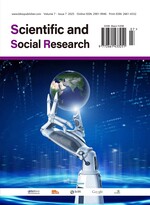Research on the Impact of Atmospheric Particulate Matter (PM2.5) on Urban Heat Island Effect
Abstract
With the rapid development of urbanization, PM2.5 pollution and urban heat island effects have become two major environmental problems that constrain the sustainable development of cities. PM2.5 is one of the important pollutants in the atmosphere, and its influence on the urban thermal environment is still insufficiently clarified. The study establishes an urban thermal environment-PM2.5 interaction model to examine the relationship between these two. The study selected a typical urban agglomeration as the research area, through the use of remote sensing monitoring and ground observation methods to obtain the PM2.5 concentration and urban temperature distribution data from 2018 to 2022. Using machine learning algorithm and thermal balance model analysis, it can be seen that PM2.5 can significantly enhance the heat island intensity by changing the urban atmospheric radiation transmission characteristics. When the PM2.5 concentration is between 75–150 μg/m3, the urban heat island intensity increases by about 0.8-1.2 °C, but when the concentration is higher than 200 μg/m3, the heat island effect will decrease due to the increased solar radiation scattering. The urban building density and green coverage are the main factors that play a regulatory role in this relationship. This paper provides a scientific basis for the comprehensive management of the urban environment, and also has important reference value for the optimization of urban planning and the formulation of air pollution prevention and control strategies.
References
Jiang ZQ, Wang XH, Feng ZH, et al., 2022, Study on the Interaction between Heat Island Effect and Pollution Island Effect in Xi’an. Arid Zone Research/Ganhanqu Yanjiu, 39(6): 1768–1781.
Wang CC, Qiu GY, Huang XF, 2018, Urban Heat Island Effect and the Relationship between PM2.5 Research. Journal of Arid Zone Resources and Environment, 32(5): 5.
Cao HL, 2016, Construction of a Shanghai Urban Forest Model for Purifying Atmospheric Fine Particulate Matter Based on the UFORE Model, thesis, Shanghai Jiao Tong University.
Liu SH, Miao YC, Guo JP, et al., 2018, Research on Atmospheric Boundary Layer Processes and Multi-Scale Atmospheric Circulation in the Beijing-Tianjin-Hebei Region and the Genesis Mechanism of Atmospheric Pollution. Symposium on Atmospheric Pollution Prevention and Control Technology.
Meng MR, 2022, Research on Urban Air Pollution and Heat Island Effect Mitigation Measures based on CFD Simulation, thesis, Guangzhou University.
Yang Y, Wang K, Cui C, et al., 2016, Numerical Simulation Study on Air Pollution during Severe Haze Period in Harbin. Journal of Harbin University of Commerce (Natural Science Edition), 2016(4): 32.
Wang Y, 2023, Study on Multi-scale Characteristics and Optimal Regulation of Ecosystem Service Revenue and Expenditure Clusters in the Suzhou-Wuxi-Changzhou Region, thesis, Soochow University.
Li F, Wang RS, Zhao D, 2013, Urban Ecological Infrastructure Based on Ecosystem Services: Current Situation, Problems and Prospects. Acta Ecologica Sinica, 2013(34): 1.
Li Y, Li YQ, Zhao JS, 2023, A Comparative Study of Atmospheric and Surface Heat Island Effects in Major Chinese Cities. Advances in Climate Change Research, 2023(5): 605–615.
Zhang HL, 2024, Research on the Influencing Factors of the Heat Island Effect in Wuhan Based on Multiple Big Data. Beautiful China, Co-construction, Co-governance and Co-sharing, Proceedings of the 2024 China Urban Planning Conference (09 Urban Ecological Planning).
Yang GW, 2022, The Impact of PM2.5 on the Heat Island Effect in key Chinese Cities and its Mechanism, thesis, China University of Geosciences.
Wu XY, 2023, Study on the Heat Island Effect and Driving Forces of Cities of Different Sizes in Shaanxi Province, thesis, Northwest A&F University.
Wu XY, 2023, Study on the Heat Island Effect and Driving Forces of Cities of Different Sizes in Shaanxi Province, thesis, Northwest A&F University.
Chen M, 2020, Research on the Built Environment of Urban Blocks based on PM2.5 Analysis, thesis, Huazhong University of Science and Technology.
Meng LH, Yang X, Liu LL, et al., 2020, Feedback Effect of Aerosols on Meteorology and PM2.5 during Heavy Pollution Processes. Environmental Science and Technology, 43(12): 63–71.

